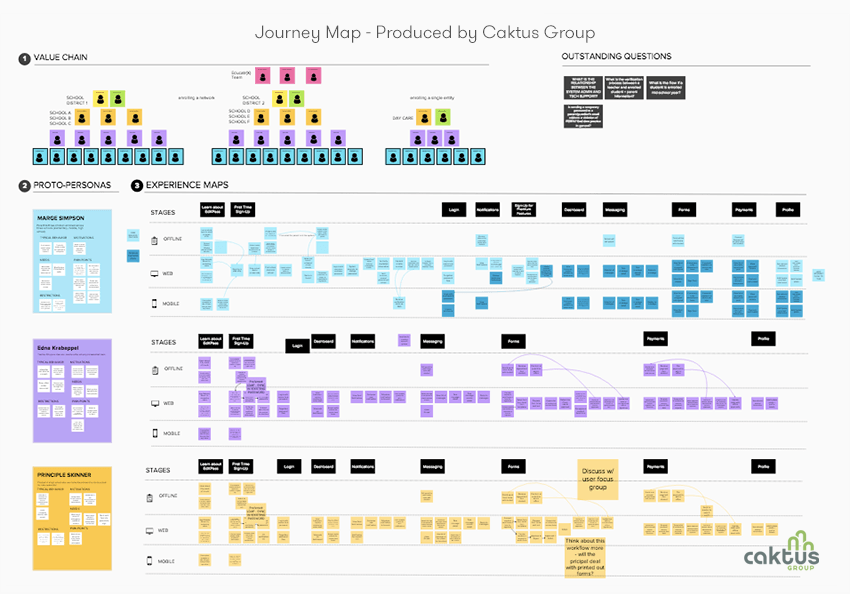
When we meet potential clients, we want to learn more about their software development needs. Beyond that, we’re deeply curious about the work they do, those involved, and the kind of impact they desire to make in the world.
Digital Principle 2, "Understand the Existing Ecosystem" embraces this idea. In many ways, the Digital Principles are an extension of conversations that are ongoing throughout the greater technology community. We're an Agile company, and one of the four propositions of the Agile manifesto reads, “Customer collaboration over contract negotiation.” No collaboration is complete without the inclusion of the user and relevant communities. We share here one of the methods we use to uphold Digital Principle 2.
A critical tool to building shared understanding: Discovery Workshop
We strive to reach a shared understanding of the existing ecosystem and to build consensus behind goals and solutions. To best produce for relevance and sustainability we collaborate with as many stakeholders as possible during discovery workshops. A discovery workshop is a method for all stakeholders to acknowledge existing assumptions. We then:
- State hypotheses,
- Brainstorm ideas, and
- Prototype solutions for any set of problems that need solving.
The client’s software development needs remain front and center, but it is through the process of building a thorough and shared understanding of the ecosystem that we can arrive at tailored solutions that address the actual needs in a more impactful way.
We use a physical, participatory process that focuses on centering the human perspective and contextual environment with all the complexities in between. Human beings learn best by doing. We also tend to make assumptions without being fully aware of them. Within the collaborative environment of a discovery workshop, we get to:
- Represent a range of perspectives,
- Create the perfect setting to dig deep into the questions that are being asked,
- Reframe the existing questions, and
- Discover new questions that may have been missed before.
A discovery workshop allows all stakeholders to suspend the focus on building the product in order to think about creating experiences first. We use established and well-researched industry tools like journey maps (pictured above) to support our efforts.
Imagine you want to build a web application to support tracking climate change in a region for local communities. In order to build a solution that will enhance rather than impede the work of community actors, it is not enough to make a list of desirable features. You can never be sure the list is complete, unless you fully understand the current workflows with their pain points and unfulfilled needs, the benefits the proposed application is expected to generate, and the contexts in which it will be used.
Understanding the contexts in which applications are being used
In order to build a successful product, we need to have a deep understanding of the outcomes the product is expected to bring about. And for that to happen, we need to learn about all contexts in which the product will function.
- Who will be using the product?
- What level of comfort with technology do its potential users have?
- Where will people be using it?
- Will they be using the product exclusively to fulfill the need or will they also be using alternative ways to accomplish the same goals.
- If the latter, will the two paths be competing with one another or will they be complimentary?
- Does the product’s functionality need to be informed by external inputs or will it be entirely independent?
Using threat modeling to mitigate risks to users
Understanding the ecosystem is also a necessary part of threat modeling. Threat modeling requires understanding the physical and political spaces in addition to the digital touchpoints. Even with the best of intentions, data and assets can be co-opted and potentially used for harm. Understanding and planning risk mitigation strategies helps to improve the impact of the final product. These perspectives are critical for delivering the kinds of products that make a lasting impact on lives and have been an important aspect of our social impact work.
Change happens and this change can save time and resources
From our experience in conducting these workshops and closely partnering with our clients, it has been rare that the original pitch for a product did not change after having gone through the discovery workshop process. In some cases, we uncovered issues in business processes that needed to be addressed before a product could be useful or successful. In one case, for example, an original product pitch required a complex printing system. As we went through the discovery process, we determined that the necessary human resources required to maintain that printing system would be difficult to implement. We decided to take printing out of the priority feature set and thus saved the client time and money with this early discovery.
Digital Principle 2 reflects best practice application design
Investing time and energy into understanding the existing ecosystem is a core digital principle because of the incredible value it adds to outcome of any project.
Within the software industry, the importance of directly answering user needs by speaking to them and understanding their world, is a long-cherished standard. Seeing this same approach promulgated throughout ICT4D via the Digital Principles can help more projects scale up from pilot projects which, in turn, can positively impact more lives meaningfully.
Discovery workshops are a tool to uncover and dig into holistic and technical questions using industry tools and best practices. However, it is just the beginning of improving products and impact as ecosystems always change.


